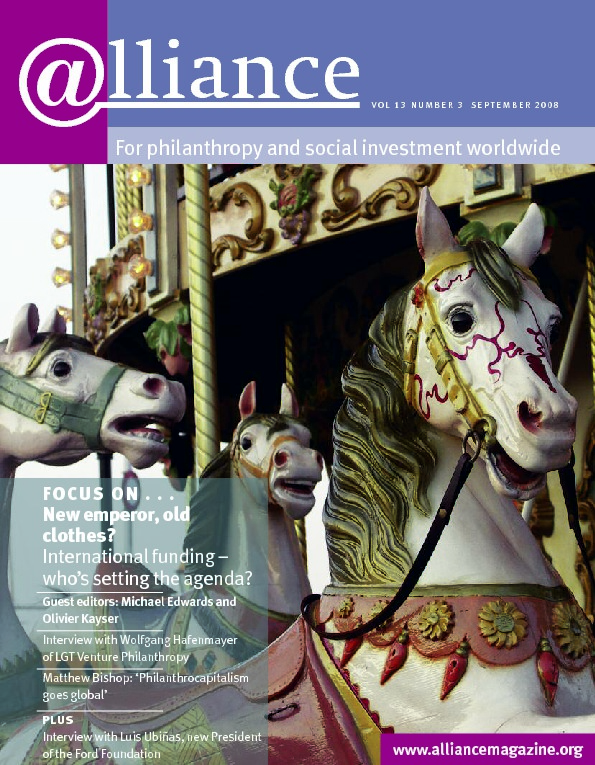 In recent years many grantmakers have endorsed cooperation among their grantees as an important way of catalysing change, yet foundations themselves make far less effort in this regard. The Network of European Foundations (NEF) has facilitated philanthropic collaboration since 2001. After nearly three years of activity, NEF has conducted an evaluation of its Initiative for Learning Democracy in Europe (ILDE). If the ILDE process has not been uniformly satisfactory, the general message is that foundation collaborations can work, but they take time and commitment from the participants.
In recent years many grantmakers have endorsed cooperation among their grantees as an important way of catalysing change, yet foundations themselves make far less effort in this regard. The Network of European Foundations (NEF) has facilitated philanthropic collaboration since 2001. After nearly three years of activity, NEF has conducted an evaluation of its Initiative for Learning Democracy in Europe (ILDE). If the ILDE process has not been uniformly satisfactory, the general message is that foundation collaborations can work, but they take time and commitment from the participants.
The NEF General Assembly established ILDE at the end of 2005 to increase the understanding of democracy and civil society throughout Europe. Today nine foundations and the Council of Europe participate actively in the project. Representatives of the member institutions make up the Steering Committee, which manages the project, meeting every six months to discuss progress. It has a chair selected from among the members. After an initial exploration phase, a second phase began in 2007 focusing on the development of two tools for use in schools: a resource kit on European citizenship education, and a handbook on democratic interaction for schools.
 In 2008, as part of the evaluation, ILDE members were asked to reply to a survey. Questions focused on individual participation, collective functionality, chairing of the Steering Committee, the contribution of NEF staff, pan-European issues, and the management of consulting groups. Among the foundations, two-thirds replied.
In 2008, as part of the evaluation, ILDE members were asked to reply to a survey. Questions focused on individual participation, collective functionality, chairing of the Steering Committee, the contribution of NEF staff, pan-European issues, and the management of consulting groups. Among the foundations, two-thirds replied.
‘Cooperation not competition’
One thing that emerged is that ILDE members overall feel confident that, individually and collectively, their skills and experience are right for the project. One member noted that the diversity among foundations in size and approach to work brings a variety of relevant knowledge to the project. The Steering Committee remarked that its collective learning has kept up with the demands of the project. By contrast, and not surprisingly, a number of comments revealed that few have any experience in foundation collaboration.
Conflicts emerged within the group in relation to the Steering Committee. Although some were entirely satisfied with the development of the work plan, others said that during the first phase of the ILDE project, members took too long to agree on what they wanted to achieve. It was also noted that there needs to be a spirit of ‘cooperation not competition’ within the group.
An effective Steering Committee chair is essential to a strong collaborative. Survey respondents noted that field knowledge, communication skills, strategic thinking, project management and time management are all essential to this role, as is the ability to support group cohesion. Finally, committee members noted the value of having an independent chair who represents the collaborative rather than his or her home institution.
The tensions among foundations revealed themselves in contrasting comments: some saw larger foundations as dominating the decision-making while others noted that those making smaller financial contributions took too much time in expressing their opinions. Despite this, members noted the critical process of developing trust through spending time together and establishing a collective work style. Discussing expectations for the role of each ILDE member, it was felt, would bring greater cohesion to the group’s work.
Embracing diversity
While the group places great importance on the European focus of its work, members noted that internally the Steering Committee has not taken account of differences. In particular, the decision to use English as the common language was not one the group took collectively, and one which created difficulties for some non-native speakers – an issue that European philanthropy needs to remain sensitive to.
Accommodating the approaches of the different types of foundation involved – operating, grantmaking; smaller, larger; local, national, international, and so on – affected the length of time it took to develop an ‘ILDE work style’. This became very evident when the members discussed levers of change. Working on a resource kit on European citizenship education was an idea backed by all members because it allowed smaller foundations to use it on a local scale and national ones to spread it throughout a school system.
Delegating responsibility
At the start of the project, and more by default than design, the group attempted to manage consultants collectively. At the start of the second phase, the group assigned two members to act as project leads and to take on primary responsibility for their respective projects and the related consultants. The development of this direct management has been tentative, and it seems that the Steering Committee needs to further bolster these direct reporting lines.
NEF’s contribution
As the administrative base for the project, NEF’s contribution is essential. It has provided administrative and procedural support before, during and after meetings and has also had to arbitrate among foundations with conflicting opinions. Being decisive while at the same time keeping foundations happy with the project’s direction remains a delicate balance for NEF.
Survey respondents commented that the Steering Committee needs to consciously define the role of NEF staff in ensuring the ILDE collaborative functions as efficiently as possible. The suggestion that NEF add an online project management system for the use of the group holds promise for improved efficiency.
Prioritizing the collaboration
There is a question of whether the representatives of ILDE members are allocated enough time by the institutions they represent to participate fully in the collaborative work. While the majority of survey respondents said they had enough time for the project, a third said they did not. In addition, reaching members between meetings was seen as too difficult, and it appears that some have not adequately prepared for meetings. Creating communication norms (email, phone, online project management, etc) within the group may assuage some frustrations.
Lessons learned
The survey shows that, from the start, members of a foundation collaboration need to identify expectations in regard to roles played, communication norms, commitment of time to the project, and administrative and consulting support. It may also be valuable to integrate an ongoing process evaluation into the project from the very beginning. This would allow the group to refine its activity and to focus more directly on the issue which brought them together in the first place.
Although the review of ILDE’s work process reveals mixed results, it indicates that the group is gaining strength. In June 2008, on the basis of the evaluation, the ILDE Steering Committee created a plan to redirect elements of their collaborative activity. Working with peers at other foundations creates the opportunity to leverage investments and to work beyond geographic and cultural limitations. The best results emerge when funders recognize the work a collaborative produces will only be as strong as the group itself.
Leslie Reed is a 2008 Fulbright Scholar and vice president for health policy at the Missouri Foundation for Health. Email reed.fulbright@gmail.com
Michael Alberg-Seberich is executive partner at Active Philanthropy. Email alberg-seberich@activephilanthropy.org
For more information
http://www.nefic.org/projects-current.php
Comment Clare Thomas
Collaboration, like its old friend ‘partnership’, is a much used and abused term, and too often loosely applied. When two foundations email about the level of grant they intend to award to a common grantee, is this collaboration?
No doubt it takes many forms. The Woburn Place Collaborative is a loose network of UK foundations, administered by the Association of Charitable Foundations, which meets twice a year to share ideas, learning and research and to broker projects of mutual interest. Participants are bound together by a commitment to ‘social justice philanthropy’, but there is no consensus on what that really means.
NEF’s evaluation of ILDE highlights many of the benefits and challenges of a more structured collaboration. Not without its hiccups, the ILDE collaboration obeys the ‘collaborative’ gurus Huxham and Vangen’s golden rule: ‘Collaborative advantage will be achieved when an objective is met that no organization could have produced on its own and when each organization is able to achieve its own objectives better than it could alone.’
There can be few projects more appropriate for collaboration. ILDE’s basic objective, to increase the understanding of democracy and civil society throughout Europe, requires a rich mix of talents and perspectives. But it wasn’t plain sailing. Tensions between large and small foundations are inevitable. Are all members of a collaborative equal or are some more equal than others? Those investing more cash may want more say. Smaller foundations can feel overwhelmed.
Risks can include lowest common denominator decisions, stifling creativity and potential impact. Not the case with ILDE, but always a danger. Compromise can result in mission drift, dilution of everyone’s brand, and reputational risk. Collaboration is also time-consuming, something that should be factored in from the start.
The role of NEF is interesting. Collaboratives need an independent anchor or lead partner, which doesn’t mean they are the boss. Protocols may sound boring but trying to identify clear roles and expectations and above all clear values and goals is essential.
Strong collaboratives inevitably have a life of their own. At their best, they produce something greater than the sum of all the parts but, as ILDE has shown, this takes time and trust to build. It’s more than foundations pooling resources, spreading costs and sharing risk. It is about greater authority and a stronger voice. Successful collaboratives are a bit like mongrels. They are strong and resilient, the results of fishing from the very best in the gene pool. However, as the ILDE evaluation has shown, they are not always ‘pretty’.
Clare Thomas is Chief Grants Officer at London’s City Bridge Trust. Email Clare.Thomas@cityoflondon.gov.uk






Comments (0)